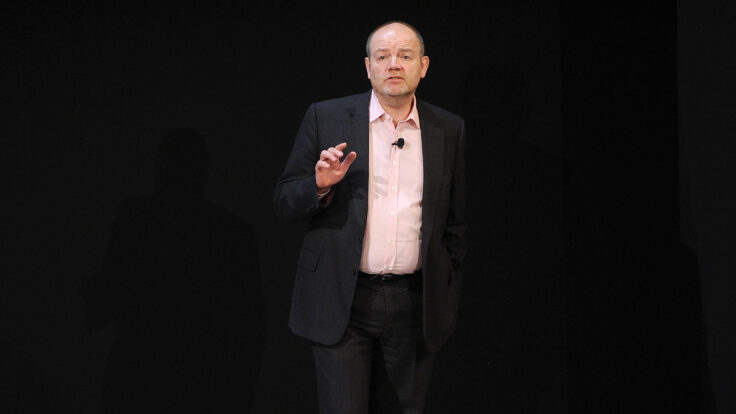 |
|
Greetings from Los Angeles, and welcome back to In the Room. In tonight’s email, news and notes on The Wall Street Journal’s Emma Tucker transformation, our era of newsroom union theater, and the latest and most painfully acute manifestation of CNN’s decline.
But first…
👀 Skydance-Paramount, cont’d: On Wednesday, I reported that Paramount Global’s special committee was expected to approve Skydance’s proposed takeover of National Amusements Inc., the Paramount parentco, within a week or so. The next morning, The Wall Street Journal reported that Skydance had submitted a “sweetened offer” for NAI, which the committee does indeed seem likely to approve. (Stick with me, folks!) In any event, it’s important to remember the committee’s approval doesn’t necessarily portend a deal. That, of course, is up to Shari.
🏀 Zaz’s NBA rights fight: David Zaslav seems to have determined that he will not compete with ESPN or NBC Sports for the NBA’s “A” and “B” packages, respectively. His options now appear to be as follows: 1) Use WBD’s nebulous “matching rights” to compete for Amazon’s “C package,” for which the streamer is expected to offer $1.8 billion a year; 2) Convince the NBA to carve out a fourth, smaller package, as my partner John Ourand reported yesterday; or, 3) Abandon the NBA altogether, which Zaz seemed to tease at yesterday’s Bernstein conference. But the NBA could argue that WBD can’t “match” Amazon in terms of reach, especially globally, and it may have no interest in offering a fourth package. (God knows NBC won’t countenance that…) At that point, Zaz could be forced to pursue the strategy he’s already laying out in his public remarks: a collection of other sports assets—NCAA basketball, MLB, NHL, etcetera—that may (or may not) sustain his existing carriage fees. Naturally, Ourand has a thorough review of all this in his latest, The Zaz NBA Backtrack.
📺 A Van Gundy resurrection?: In my report this week on possible media talent moves in the new NBA landscape, I forgot to mention one piece of scuttlebutt that came my way from industry insiders: curiosities about whether NBC or Amazon bring might back color commentator Jeff Van Gundy, who was let go during the Disney layoffs in 2023, along with his on-air wingman Mark Jackson. The general consensus, of course, is that ESPN’s decision was incredibly misguided. Indeed, a recent headline from The New York Times’ Athletic declares: “One year after Jeff Van Gundy’s dismissal, ESPN’s NBA broadcasts are worse off.” Who knows how this all shakes out, but I have to imagine there will be some discussions.
And now to the main event…
|
 |
| The Post-It Episode |
| News and notes on the Journal newsroom’s Post-It protest and CNN’s month to forget. |
|
|
|
| On Thursday afternoon, several disgruntled staffers at The Wall Street Journal made a brief march to the office of Emma Tucker, their sprightly, charismatic, and still new-ish editor-in-chief. Since she arrived at the Journal in late 2022, following a stint running The Sunday Times, Tucker has embodied the role that some organizations call a change agent or a transformation executive. In other words, she’s gone through the byzantine org charts and weeded out a lot of employees who got away with not doing a whole lot of work for a long time, or focused their attention on avocational parts of journalism, like mentorship.
In the process, Tucker has pissed off plenty of the institutionalists within her realm. But she’s also made the Journal better, quicker, less erudite. And I’m not just talking about risqué exposés, like that Musk–Shanahan–Brin piece. The Journal had the news of the Paramount deal denouement (albeit after I first flagged it) earlier this week. Even today’s exclusive story about Bill Ackman considering an I.P.O. for Pershing Square, which would capitalize on his new culture warrior street cred, evinces some of the cheeky wit of the Tucker era.
Anyway, not everyone is a Tucker acolyte. After the Journal staffers arrived outside her office, they posted about five or six dozen brightly colored Post-It notes on its glass wall. The stunt was intended to protest Tucker’s decision to restructure the U.S. news desk, a move that will result in the elimination of eight positions, though it came off looking like a kindergarten arts-and-crafts installation. Staffers took photos of their triumphant display and distributed them to a few media reporters, including one at the Times, where they eventually found their way to X. “Do you think this is very helpful?” Jo Bull, Tucker’s veteran, no-bullshit assistant, reportedly asked. “Do you want to stick them on me?”
One wonders what the Abbie Hoffmans of yesteryear would have made of this era of uninspired newsroom protests. At Condé Nast, of course, staffers found multiple occasions to march up to C.E.O. Roger Lynch’s office, stage Oscars-themed walkouts or, in a pitch-perfect expression of the W.F.H. era, bombard Lynch and Anna Wintour’s inboxes with sassy reply-alls. The New York Times just concluded its own endless labor ordeal. (The Washington Post newsroom, to its credit, orchestrated a massive walkout last year, with more than 750 employees participating in a 24-hour work stoppage; L.A. Times staffers staged a similar protest in January.) In any event, it felt like some perspective had been lost on Thursday. The Journal itself has provided some of the most thorough coverage of layoffs across various industries and sectors in recent years, sometimes targeting tens of thousands of workers at a single company. Thursday’s cuts, as noted, will affect eight employees, all of whom have been invited to reapply for the more than 30 gigs currently on offer at the Journal.
To be clear, no one wants to see people lose their jobs. But even successful publishers, like the Journal owner Dow Jones, are navigating a complex landscape that involves the coming tsunami of artificial intelligence, the need for recurring revenue, and new distribution systems. And as print continues to fade, they also realize that their businesses require different kinds of jobs and functions—and more-modern performance-management structures, too. In the process, they also need to be transparent with their employees about which skills matter more in the coming era than in the one just eclipsed. The media business is a business, a fact many journalists still somehow struggle to internalize, even at a place like the Journal.
The misalignment between journalists and their leaders is often a feature of news organizations. After Washington Post C.E.O. Will Lewis recently informed his newsroom that they had lost half their audience since 2020 and $77 million in the last year, many were quick to rewrite the narrative by pointing to Pulitzers won or colleagues they had prevented from going to the Times. And sure, there are occasionally senseless layoffs—such as when former ABC News chief Kim Godwin used cost cuts to exorcize her perceived critics, despite their value to the organization—but there are also job cuts whose only purpose is to sustain the growth that will keep other people employed, such as at the Journal, over the long term.
Thursday’s protesters appeared to take issue with the fact that Tucker was implementing these eight layoffs despite the fact that the Journal is growing digital subscribers, and netting strong profits for Dow Jones. Much of the media coverage of the layoffs also noted that, in addition to these profits, the Journal had just inked a nine-figure licensing deal with OpenAI. But the Journal’s success on these fronts doesn’t mean Tucker can rest on her laurels, nor does it negate the need to further restructure the paper for future growth. This week’s layoffs weren’t the first—she recently cut jobs in Washington and abroad—and they won’t be the last. Meanwhile, the union-led guerilla tactics are unlikely to inspire a lot of empathy. They also seem to be misdirected. Sure, the protesters act like they hate their bosses, but their true nemesis is the inchoate and irreversible transformation their bosses represent.
|
|
|
| Elsewhere on Thursday, at a Q&A session at the Bernstein Strategic Decision Conference, Warner Bros. Discovery chief David Zaslav was asked to address the recent ratings struggles at CNN, where Mark Thompson has now spent seven months trying to engineer his still highly anticipated multiyear path toward digital reinvention. In very typical fashion, Zaz waved off the concern: CNN was “a trusted global brand for news,” very different from its partisan competitors at MSNBC and Fox News, and the “currency” of global trust had the potential to make CNN “a very big business.” It was, in many ways, quintessential Zaz: optimism, pablum, and evasion.
“Trust” is a nice talking point and an often conveniently hard-to-quantify metric, but it’s fair to say that its most meaningful expression is registered in the way audiences actually engage with a news brand at times when there is real news. CNN has spent decades drawing fewer viewers than its partisan competitors on any given weeknight, but the brand has historically dominated the landscape when the news breaks. In the Jeff Zucker era, CNN drew more viewers than all of its cable and broadcast competitors on the night of the 2016 election, came in second only to Fox News four years later, and registered the highest ratings in its history in the months around the election.
Indeed, as recently as January 6, 2021, CNN bested not just Fox and MSNBC but also the broadcast networks—and this was true no matter how you chose to frame it. They won total viewers, 25- to 54-year-old viewers, and 18- to 34-year-old viewers during the insurrection—averaging almost 9 million viewers total. And they won them again during the primetime coverage, with more than 8 million viewers total.
CNN’s performance on January 6 demonstrates how “trust” actually translates to value. Today, audiences may still perceive CNN as a more reliable arbiter of news than its partisan competitors (though American conservatives certainly don’t, despite Chris Licht’s efforts to depolarize the network), but it hardly matters if they don’t bother to watch it—and especially if they don’t bother to watch it when demand for reliable reportage is ostensibly at an all-time high. Ninety-five percent of Americans may be aware that Starbucks serves reliably consistent and halfway decent coffee, but it doesn’t matter if they don’t show up to order it every morning.
In any event, a few hours after Zaz made his remarks at Bernstein, Judge Juan Merchan informed reporters at the Manhattan Criminal Courthouse that the jury would issue its verdict on the Trump hush money trial. I don’t need to point out that this was not just breaking news, but living history, marking the first time ever that a former (and aspiring) president of the United States could become a convicted felon. And yet, in the 5 p.m. hour when the verdict came down—guilty, guilty, guilty, etcetera—CNN drew a mere 2.6 million viewers, according to Nielsen. This was more than one million fewer than MSNBC, and more than two million fewer than Fox News. (As a silver lining, CNN did beat MSNBC in the demo that hour.) Meanwhile, CNN would also lose the night’s primetime analysis block to MSNBC, which came in first with 3.4 million viewers, and Fox News, which drew about 3.1 million. CNN’s audience was less than 1.3 million.
Now, there is an obvious macro-observation to make here, which is that the total television news audience is diminishing as more and more people cut the cord and rely on social media and push notifications and the like for their news updates. That’s the primary reason Thompson is trying to position CNN to better compete in digital and on streaming. But that strategy is still a long way from coming to fruition. From a revenue perspective, at least, CNN is still very much linear-first.
Meanwhile, the company refuses to release any digital or streaming metrics by which the industry might otherwise judge them. When I asked a CNN spokesperson about the network’s performance on CNN Max during the verdict, she told me that it was the second-best day for the streaming product after Andy Cohen and Anderson Cooper’s New Year’s Eve broadcast, but declined to provide specific numbers.
For one night in June, at least, CNN will command record audiences, and ad revenue, when it hosts the first presidential debate. Beyond that, it is demonstrably losing engagement with audiences, and effectively forfeiting its claim, and indeed its raison d’être for the last 44 years, as the network people turn to when news breaks—which is a real testament to just how much you can damage a brand in three years.
|
|
|
|
| FOUR STORIES WE’RE TALKING ABOUT |
|
|
|

|
 |
|
|
|
Need help? Review our FAQs
page or contact
us for assistance. For brand partnerships, email ads@puck.news.
|
|
You received this email because you signed up to receive emails from Puck, or as part of your Puck account associated with . To stop receiving this newsletter and/or manage all your email preferences, click here.
|
|
Puck is published by Heat Media LLC. 227 W 17th St New York, NY 10011.
|
|
|
|







